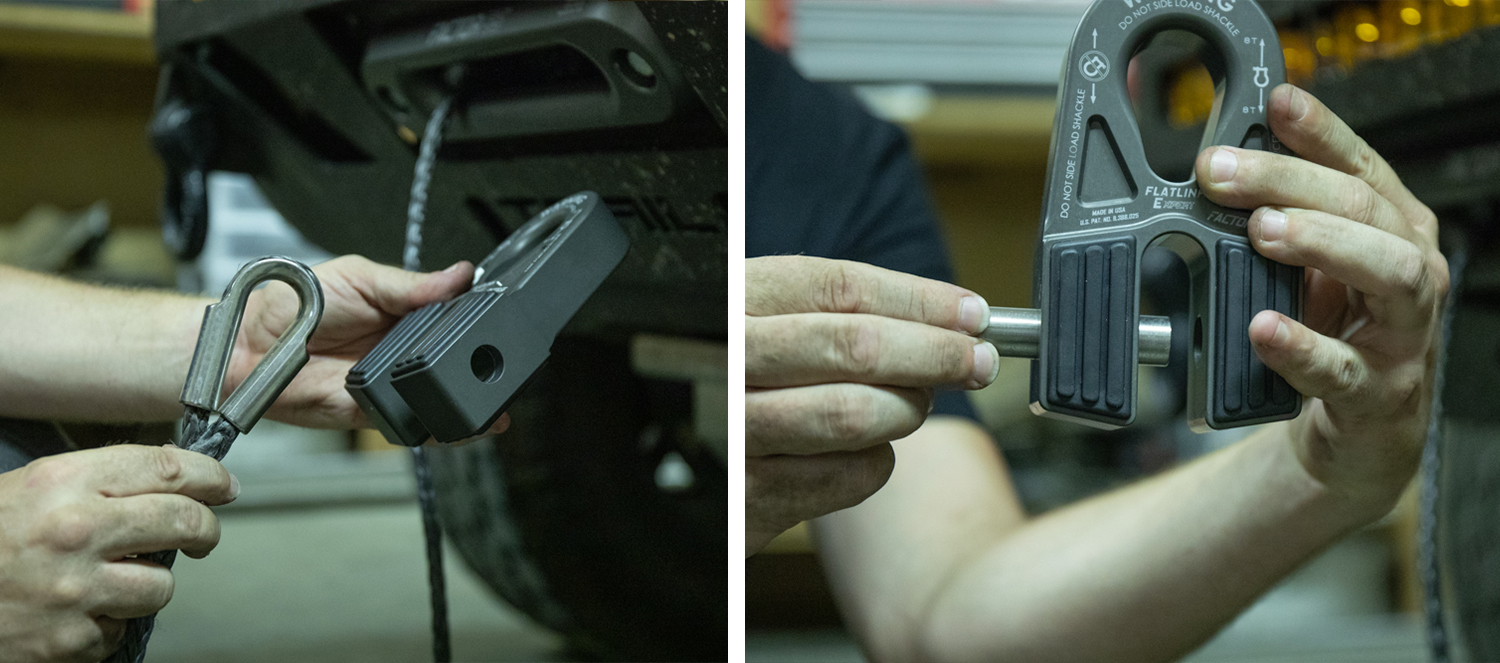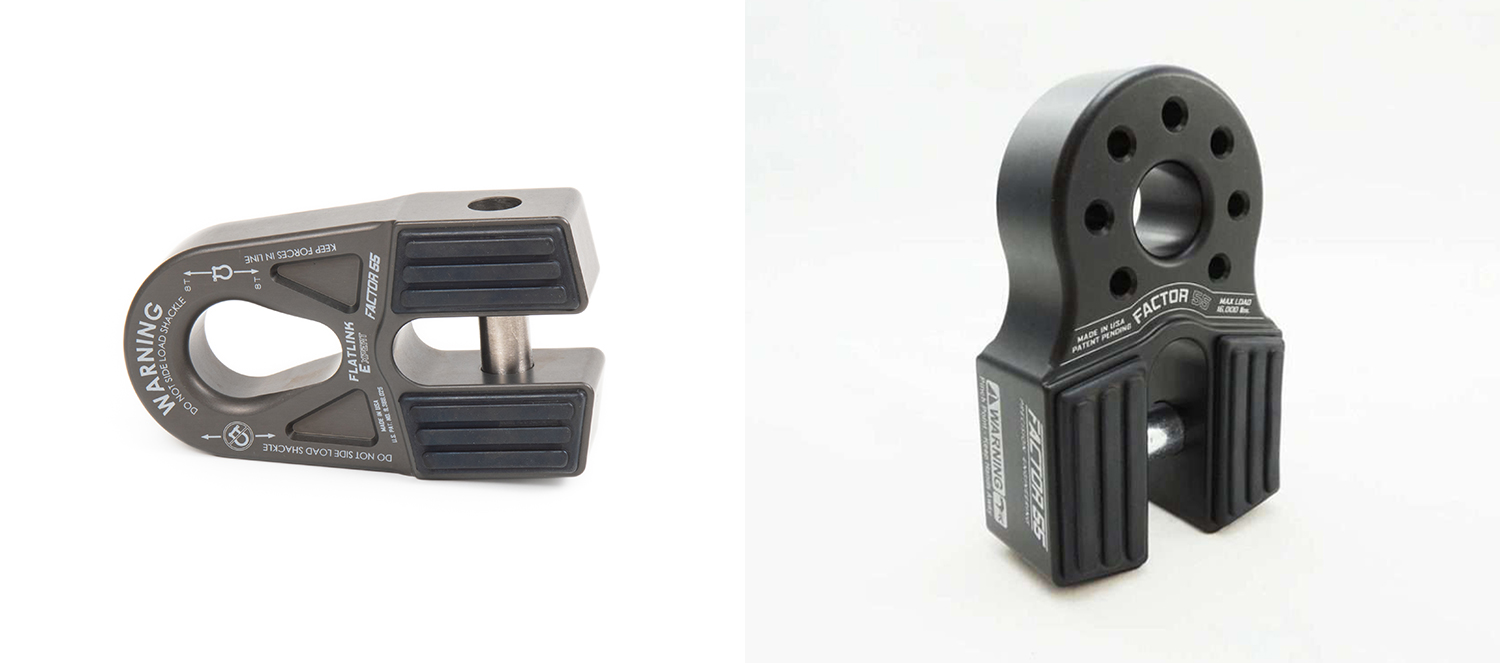
Everything you need to know about the Factor 55 FlatLink E – Install, Review, Overview and more
When we ordered our C4 Fabrication Lo Pro bumper, we opted to add a winch. We chose to add the Smittybilt X2O 10K winch along with a Baja lightbar. We swapped out that lightbar with a KC HiLiTES 30″ FLEX lightbar, and wow, that was an impressive addition.
Even though the C4 Lo Pro with a Smittybilt X2O 10K winch and the KC HiLiTES 30″ FLEX was a great addition to the 4Runner, it still wasn’t perfect.
The Smittybilt X2O comes with a synthetic rope, an aluminum fairlead, and a forged hook that is permanently attached to the end of the synthetic rope.
There is nothing technically wrong with this set-up out of the box. The aluminum fairlead is quality and the forged recovery hook attached to the end of the synthetic rope is solid.
You can permanently mount your hook outside the bumper onto a D-ring and call it a day but most experienced off-road drivers replace their winch hooks “Clevis Slip Hooks” with safer, more dependable screw pin shackles.
Let’s look at the difference between these two.
Clevis Slip Hooks

- WLL: 4000-8000lbs
- Breaking Strength: 20,000-30,000lbs
Most common clevis slip hooks are 3/8″, have a working load limit (WLL) of 4000-8000lbs, and breaking strengths of 20,000-30,000lbs (this was one of the better options I could find). Breaking strength and working load limit (WLL) really just depends on the brand.
Screw Pin Shackle & Winch Line Shackle Mounts

- WLL: 8500-9500lbs
- Breaking Strength: 50,000-60,000lbs
On the other hand, you have screw pin shackles/D-rings. Most 3/4″ screw pin shackles have a working load limit (WLL) of 8500-9500 pounds, and a design that is built for even the most novice of off-roaders. On top of that, the breaking strength far outweighs the clevis slip hooks at 50,000 to 60,000 pounds. Factor 55 makes a similar product in terms of WLL, however, design-wise, it is completely different. These products are known as a Winch Line Shackle Mounts (pictured above is the Factor 55 FlatLink E).
Winch hooks (clevis slip hooks) – potential problems:
- Lower WLL
- Lower breaking strength
- Awkward for hooking up recovery straps
- Sharp edges can cut recovery straps
- Not safe to use with recovery straps
- Awkward storage against the fairlead
- Exposed rope to the elements
Common concerns with Clevis slip hooks

Clevis slip hooks are built for chain links, not recovery straps. It’s weird to think that companies like Smittybilt, WARN and others are shipping winches with these hooks. Because let’s be honest, these hooks are not ideal for synthetic recovery straps.
The sharp edges on these hooks can likely cause cuts and abrasions over-time which can lead to catastrophic failure once you depend on the winch in a recovery situation. It may sound extreme but this is one area of off-roading you want to be extremely cautious about.
Most off-roaders use a screw pin shackle to hold straps and clevis slip hooks are just awkward and not really compatible with a wide variety of the recovery parts we carry.
How do they work with fairleads
The clevis slip hooks don’t suck up very neat against the fairleads either. If you have a Hawse fairlead, a hook hanging directly off the front would look really obnoxious and it offers no protection from a direct-forward approach angle.
If you have a roller fairlead, at least it’s somewhat tucked behind something if an obstacle hits from the front, but even here it’s clunky and awkward. Hooks are not designed to suck up tight against the fairlead which is why you see cables extended and hooks attached to D-ring mounts welded on bumpers.
Many winch manufacturers encourage you to spool your entire winch cable or synthetic rope up on the drum while not in use. This does not mean pulling your line out to a D-ring mount on your bumper and leaving your rope or line exposed.
If it’s not already obvious, this can permanently weaken the fibers on your cable or rope right where the material rope rests on the fairlead corner.
The FlatLink E by Factor 55

As we mentioned, traditional winch hooks can cut your recovery straps and can possibly even let straps fly off during the recovery process. This is why most experienced off-roaders use closed system screw pin shackles or other closed system shackles, such as the Factor 55 FlatLink E.
The FlatLink E is compatible with steel cables or synthetic ropes up to 3/8 inches in diameter. The eye on the end of your winch cable is held by the 5/8 inch diameter 6Al4V Titanium double shear pin and internal snap ring.
This shackle is equipped EPDM (ethylene propylene diene terpolymer) rubber guards on the outside of the FlatLink protects alloy fairleads and are securely attached to shackle with 4 barbed tips each.
The FlatLink E is compatible with either roller or Hawse type fairleads (such as the Factor 55 Hawse Fairlead) and is designed to be used with common 3/4″ shackles.
The Factor 55 Closed Winching System
-
- FlatLink E: Check Price
- Hawse Fairlead: Check Price
- Rope Guard: Check Price
- Crosby D-Ring USA-made Shackles: Check Price
The elimination of the winch hook and the subsequent substitution to a Factor 55 ProLink, FlatLink, or UltraHook shackle mount and commonly found screw pin shackles/D-Rings is a CLOSED SYSTEM winch system. – Factor 55
FlatLink E Installation
Installation only takes a few minutes.
Step 1: Cut off your old hook

Tape your rope line in case of sparks. This is not a mandatory step but a basic precaution if you don’t want a spark to catch your synthetic rope.
Now, remove your existing winch hook from your winch cable or synthetic rope. You do this by cutting the hook with your cutting tool of choice.
Using the angle grinder, I made two cuts in the bottom of the winch hook.
Step 2: Remove snap ring and double shear pin

Using snap ring pliers, remove the snap ring and double shear pin from the Factor 55 FlatLink.
Step 3: Insert Rope Eyelet & Insert Pin

Insert the rope eyelet into the Factor 55 FlatLink and reinstall the sheer pin. The image on the right is for a visual purpose only to give you an idea of sliding the pin through the FlatLink. You will slide this pin through the eyelet of your synthetic rope line and into place. The final result will look like the image below on the left.
Step 4: Make sure the snap ring is completely seated

Be sure that the snap ring is completely seated into the snap ring groove and that’s it, you’re all done.
When retracting the synthetic rope back onto the winch assembly, it is advised to snug the FlatLink up against the Hawse Fairlead with some tension in the line.
As you spool the line back onto the drum, get the FlatLink snug against the fairlead. Now click the remote one last time to pull the winch in and it should be extra tight against the fairlead. This will keep the FlatLink coming loose and shifting onto the fairlead.
It is also very important to note that you should keep your fingers away from any potential he dangerous area here.
General Wear and Tear
Over time your Factor 55 FlatLink may show signs of wear and tear through fading and scratches. This is generally common wear and tear of anodized aluminum parts.
Over time and general usage, you can expect the parts to fade however these parts will last for many years. Factor 55 makes all of their parts in the USA and backs all their products with a one-year warranty.
Domestic vs Import Shackles

The Factor 55 FlatLink is designed to be used with a standard 3/4″ screw pin shackle. All domestic shackles will fit the FlatLink, but some of the low-quality import shackles from china may not fit. The space between the shackle legs may be too narrow to fit the FlatLink.
Factor 55 obviously does not encourage the use of these low-quality shackles due to the wider range of gaps between the shackle legs, as well as the uncertainty of steel alloy composition. Always test the fitment of your shackle with the FlatLink prior to your offroad adventure.
Factor 55 sells Crosby Group USA-made shackles and recommends these for use with all their products.
FlatLink E (Expert) or Standard FlatLink?

The FlatLink E (Expert) is an upgraded version of the standard FlatLink. The major difference is the shape.
The standard FlatLink has a single 3/4″ screw pin shackle hole. The FlatLink E has a large pear-shaped hole that allows for attachment to either the pin or bow end of common screw pin D-ring or 3/4″ screw pin shackle. The
FlatLink E also works better with some of the more common OEM recovery points on our 4Runner’s, Tacomas, and Tundras.
One very important note to consider here is safety. The standard FlatLink is technically safer than the FlatLink E. Because the standard FlatLink has one orientation for a D-ring, it is not possible to sideload the shackle.
To sideload a shackle means to pull it from the side as opposed to straight on.
Shackles WLL (working load limit) and breaking strength is rated from a straight pull, not from the side.
Sideloading a shackle can be dangerous as weight ratings and breaking strengths are not measured here. Not to mention the fact that recovery straps can get caught or hung up in awkward positions when sideloading shackles.
When setting up a shackle for a recovery situation, you often have momentary slack conditions where your recovery strap can suddenly fall to the side of your shackle. If you’re not paying attention, you can sideload a shackle very fast.
If you are just getting into the off-road world, and have never attempted a recovery, you may want to look at the standard FlatLink shackle mount due to the shackle pin mounting constraint.
FLATLINK E TESTING RESULTS

Breaking Strength
- Peak Load: 42.100Ibs.
This is straight from Factor 55. The above test was made on the 51 Boise Rigging Supply test machine. Boise Rigging Supply makes no warranties, nor assumes any responsibility whatsoever for the use or applicability of items tested. The end-user assumes all such liability.
Final Thoughts?

If you just got a winch or are soon getting a winch, you should consider grabbing one of these closed system winch shackles from Factor 55.
Whether you get the FlatLink E or the original FlatLink, either option will be better than the clevis slip hooks that come with your winch.
These hooks will work, and they might get the job done but you better close your eyes and turn your back when that winch line gets tight because boy, those hooks can be sketchy.
